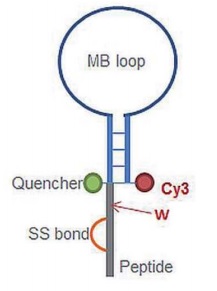A Molecular Beacon for Cancer Point-of-Care Diagnostics
“Point-of-Care” can positively impact health care delivery as well as address challenges of health disparities.
What is “Point-of-Care”?
In the early days of modern medicine, medical doctors would visit patients at their home resulting in a first form of “Point-of-Care”. However, as modern medicine developed, the overall care of patients shifted to specialized hospitals aiming to cure diseases and doctors now no longer consider it essential to visited their patients at home, rather patients now, especially new patients, have to wait in line for a visit at their family doctor or any other specialized doctor. Luckily, in recent decades, sensor technologies were developed, enabling the rapid analysis of blood samples for a multitude of critical care assays, including blood chemistry, electrolytes, blood gases, and hematology. Also, modern biosensors now allow toxicology and drug screening, the measurement of blood cells and blood coagulation, bedside diagnosis of heart disease through detection of cardiac markers in the blood, as well as glucose self-testing. Current developments in point-of-care testing utilize nanotechnology in medicinal chemistry to develop “Point-of-Care” tests for the diagnosis and treatment of cancer, stroke, and cardiac arrest.
New approaches in “Point-of-Care” can positively impact health care delivery as well as address challenges of health disparities. Furthermore, portable diagnostic and monitoring devices for point-of-care testing could shift modern medicine from curative medicine to predictive and personalized medicine.
Utilizing nanotechnology allows the design of improved functionalized biosensors. For example, employing nanophotonic technology enables the design of high-performance biosensors that can provide high sensitivity, compactness, and a shorter time to result, as well as label-free detection, and reduced sample volumes.

Figure 1: Image of a molecular beacon construct.
Nanophotonics or nano-optics refers to the use of light at the nanometer scale often involving metallic components that can transport and focus light via surface plasmon polaritons, infrared or visible-frequency electromagnetic waves traveling along a metal-dielectric or metal-air interface. Gonçalves et al. recently reported the design of a molecular beacon conjugated to a light-activated cysteine peptide for label-free detection of the miRNA-21 by using integrated photonic sensing structures. A photonic technique called Light Assisted Molecular Immobilization (LAMI) enables detection of the miRNA with the help of the molecular beacon. The construct contains a sequence complementary to the cancer biomarker miRNA-21 allowing the detection of the microRNA via hybridization. Also, the construct consists of a Cy3 labeled molecular beacon covalently attached to a light-switchable peptide. However, crucial to the success of the molecular beacon construct is the use of the light-activated peptide KAMHAWGCGGGC-NH2 conjugated to the molecular beacon. This peptide contains a sequence motif with tryptophan in close spatial proximity to a disulfide bridge. The peptide allows the light-activated immobilization to thiol-reactive surfaces. The light-activation via UV excitation at 275 to 295 nm of the aromatic residue side chain induces electron ejection that is thought to react with the nearby disulfide bridge forming a disulfide electron adduct. The resulting short-lived adduct dissociates to free thiol groups that covalently binds the peptide to the thiol-reactive surface.
MicroRNA miR-21 as a cancer biomarker is frequently upregulated in solid tumors, as well as in B cell lymphomas. miR-21 inhibits the expression of phosphatases, thereby limiting the activity of signaling pathways AKT and MAPK. miR-21 is associated with a wide variety of cancers which occurs in breasts, ovaries, cervix, colon, lung, liver, brain, esophagus, prostate, pancreas, and thyroid.
Reference
Gonçalves, Odete,Wheeler, Guy, Dalmay, Tamas, Dai, Houquan, Castro, Miguel,Castro, Patrick, Garccia-Rupѐrez, Jaime, Ruiz-Tórtola, Ãngela, Griol, Amadeu, Hurtado, Juan, Bellieres, Laurent, Baňuls, Marria, González, Daniel, Lopez-Guerrero, Jose, Neves-Petersen, Maria; (2019). Detection of miRNA cancer biomarkers using light activated Molecular Beacons. RSC Advances. 10.1039/c9ra00081j. [Article]
---...---